FY 2006 Hearing on Substance Abuse and Mental Health - Deputy Director's Statement Before the House Subcommittee on Labor-HHS-Education Appropriations
Statement by Faye J. Calhoun, D.P.A., M.S., Deputy Director
National Institute on Alcohol Abuse and Alcoholism
National Institutes of Health
Department of Health and Human Services
April 27, 2005
Mr. Chairman and Members of the Committee, thank you for inviting me to update you on the activities ofthe National Institute on Alcohol Abuse and Alcoholism (NIAAA). I am Faye Calhoun, Deputy Director of the Institute. I am pleased to join my distinguished colleagues here today, whose Institutes and agencies are involved in several productive collaborations with NIAAA. The fiscal year 2006 President's budget request for NIAAA is $440,333,000.
The Centers for Disease Control and Prevention rank alcohol the number-three preventable cause of death in the United States ( Figure 1). Alcohol's biological and social reach is remarkably pervasive and requires research collaborations with many fields, from social policy and behavior to genetics. The problems attributable to alcohol abuse and alcohol dependence exceed the scope of any single institute or agency.
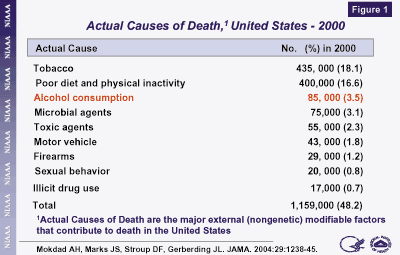
Adults legally can, and will, continue to use alcohol. Figure 2 shows the physiology of drinking too much, too fast, and not accounting for the delayed absorption of alcohol in the stomach. Blood alcohol levels go quickly from that which is stimulatory to those that are sedative-hypnotic and cause death. A recent analysis of our National Epidemiologic Survey on Alcohol and Related Conditions, or "NESARC," has revealed that drinking in excess of four drinks per occasion for men, three drinks for women, even less often than once a week is associated with a 33-fold increased chance of being alcohol dependent (Figure 3). Developmental factors also influence the risk in underage youth, a troubling number of whom drink, even though alcohol is illegal for them. Ourmission is to understand the complex biological and environmental factors that contribute to alcohol abuse and alcoholism, so that we may better understand how to prevent and treat them in people of every age.
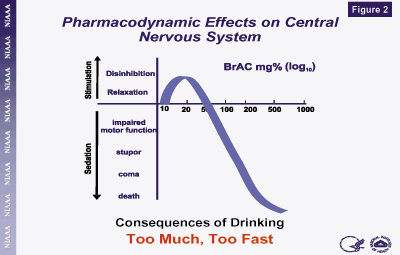
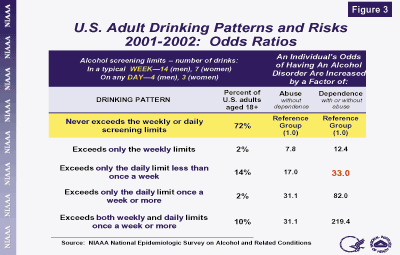
Last year, I reported to you that 18- to 24-year-olds have a much higher rate of alcohol dependence than any other age group in the U.S. Alcohol also is the drug of choice of adolescents ( Figure 4). This year, I will report to you on NIAAA collaborations that are advancing our research on reducing underage drinking, and collaborations in other key areas of NIAAA research. Advances in science, particularly neuroscience, and technology have enabled us to make remarkable progress in these areas. Our advances often are accelerated by collaborations with other Institutes, such as the National Institute on Drug Abuse (NIDA) and the National Institute of Mental Health (NIMH), whose diseases of interest have some common underlying biological and behavioral pathways. Collaborations with groups that share concerns about the clinical applications of research findings are equally important.

In addition to the finding that 18- to 24-year-olds have the highest prevalence of alcohol dependence - the data generated by NIAAA's NESARC studies - other troubling findings on underage drinking are being revealed. For example, youth who began drinking before age 15 are four times more likely to become alcohol dependent at some point in life than are those who started at 21, and are more likely to have the more severe and recurring kind of alcoholism.
The Institute of Medicine developed recommendations on underage drinking in 2003. Since that time, NIAAA has taken on the role of scientific lead in the Interagency Coordinating Committee on Prevention of Underage Drinking chaired by the Substance Abuse and Mental Health Services Administration (SAMHSA). Last month, NIAAA held a second meeting of experts convened to guide the field of research on underage drinking, including research on strategies to ensure that relevant study results are incorporated in clinical practice and community prevention efforts. Participants included the National Institute of Child Health and Human Development, NIMH, NIDA, SAMHSA, the National Highway Traffic Safety Administration, Federal Trade Commission, and experts from the media and the public policy arena, including Governors' spouses. Representatives from Mothers Against Drunk Driving, the Center for Science in the Public Interest, and the alcohol industry also attended.
Several NIAAA initiatives on preventing underage drinking are underway ( Figure 5), including a Center to Prevent Alcohol-Related Problems Among Young People; a research collaboration with colleges, to provide rapid responses to those with urgent alcohol problems; the Mississippi River Delta Project, which is examining whether a prevention strategy recommended for college students by the NIAAA Task Force on College Drinking is effective for rural adolescents; a collaboration with the Office of Juvenile Justice and Delinquency Prevention, to determine if enforcement of existing laws will reduce underage drinking; and a new collaboration between NIAAA and NIDA, to examine the consequences of drug abuse and alcohol exposure on development of the brain and behavior.
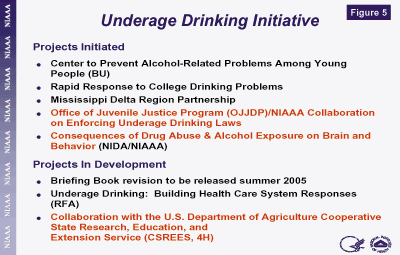
We also have several projects under development, including a major effort to improve the response of health-care systems to underage drinking, in collaboration with academic health centers in rural areas; and discussions with the Department of Agriculture regarding potential research collaborations with 4-H Clubs.
Medication development is another priority at NIAAA and is among its expanded initiatives announced for FY 2006 ( Figure 6). Our scientists are working in a public-private partnership with a pharmaceutical company on a clinical trial of a compound that acts on a brain system not addressed by the three medications currently approved by the FDA for alcoholism treatment. Neuroscience and genetics research have made remarkable progress that is enabling us to identify potential molecular targets for medications. NIDA contributes to our Collaborative Study on the Genetics of Alcoholism, which identifies genetic and molecular variants that influence alcohol and drug behaviors, providing potential targets. NIAAA and NIDA also are collaborating on a pharmacotherapy project on comorbidity, as noted below.
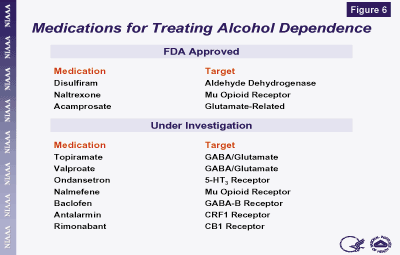
COMORBIDITY IS COMMON
Comorbidity - simultaneous substance-use and other mental disorders - is an area in which collaboration takes on special significance. Last year, SAMHSA reported that 4 million American adults have this kind of comorbidity. NIAAA's NESARC, to which NIDA contributes funds, supports the significance of this relationship, especially in treatment-seeking populations. For example, forty-one percent of people seeking treatment for an alcohol-use disorder have a concurrent mood disorder that wasn't substance-induced.
The challenges that comorbidity presents extend beyond teasing apart the complex biological and environmental factors that contribute to it and identifying the most effective treatments, although research in these areas is essential. The chronic, relapsing nature of these disorders is not well served by our acute-care model of health-care delivery, and we must also determine how to increase the likelihood that comorbid substance-use and mental disorders will be diagnosed and treated appropriately. The consequences of missing treatment opportunities are not trivial; the Journal of Occupational and Environmental Medicine reported, in 2003, that the 10 mental health disorders most costly to six major U.S. employers include alcoholism and mood/anxiety disorders.
NIAAA-funded researchers are making strides in treatment of comorbid patients. We recently found that the drug valproate reduces drinking in alcoholics with bipolar disorder, who usually do not respond to alcoholism treatment. Additional NIAAA studies, many of them collaborative, are examining medications for a variety of mental disorders and addictions that co-occur with alcohol-use disorders. In 2004, NIAAA and NIDA jointly issued an announcement seeking applications for grants to study pharmacotherapy for alcohol and drug comorbidity. As part of a NIMH project on suicide, NIAAA is funding research at a Center that is focusing on medication development for suicidal adults and adolescents with alcohol problems. We also are collaborating in a NIMH project on the effects of heavy drinking on depression. NIAAA is funding one of seven Centers that are part of a National Cancer Institute and NIDA project on tobacco addiction. In addition, we contributed to a recent SAMHSA conference on improving care for comorbid disorders.
INTERNATIONAL PROJECT TO IMPROVE DIAGNOSTIC CRITERIA
NIAAA, NIDA, and NIMH are leading an international collaboration with the American Psychiatric Association (APA) and the World Health Organization (WHO) to improve the accuracy of criteria used for diagnosing mental disorders and substance-use disorders. Current criteria in the Diagnostic and Statistical Manual of Mental Disorders (DSM) IV, issued in 1992, provide the basis for diagnoses that clinicians enter in medical records and related ICD codes for insurance documents.
Alcohol researchers and others also use the DSM criteria to determine diagnoses in studies of disorders such as alcohol dependence. The revision of the DSM criteria will not only improve the accuracy of diagnoses of alcohol-use and other mental disorders, but also capture new diagnostic information about their genetic and neurological underpinnings. The long-term impact on mental and substance-use disorders will be significant. NIAAA has developed statistical models that will enable this enhancement.
BENCH-TO-BEDSIDE REQUIRES EDUCATION
Of special concern to us, at this juncture, is ensuring that the public benefits from the findings that our research generates. The health-care provider community, including the insurance industry, has not been responsive to new findings from alcohol-treatment research, a signal that current education and dissemination efforts - while necessary - have not been sufficient. New treatments are becoming available; for example, within the past decade, the FDA has approved two medications for alcoholism (naltrexone and acamprosate). One way to help close this translational gap would be to establish a program to develop clinical scholars and investigators as core faculty specializing in substance-use disorders at health-professional schools, a suggestion offered by NIAAA at the recent White House Leadership Conference on Medical Education in Substance Abuse. We are hopeful that others with similar interests will join us.
Despite the prevalence of alcohol-use disorders, and numerous findings on the benefits of brief interventions in clinical settings, screening for alcohol problems traditionally has not been a routine part of medical practice - in part because policies for reimbursement for this important activity vary from state to state. In 2003, the NIAAA issued a practitioner's guide for screening and addressing alcohol problems, and we were joined by the American Medical Association in distributing it. An update to the guide, now in progress, will include critical new data from NIAAA's NESARC studies and will expand the audience to mental-health professionals. We are working closely with SAMHSA's CSAT, the Department of Veterans' Affairs, American Society of Addiction Medicine, American Academy of Addiction Psychiatry, and Association for Medical Education and Research in Substance Abuse in this effort.
Another avenue for education is the NIH Blueprint for Neuroscience Research, a collaboration of 15 Institutes. Its training component, in which NIAAA will participate in 2006, will help neuroscience graduate students and postdoctoral investigators link research to clinical applications.
DIVERSITY
NIAAA recognizes that different populations vary in their risk of alcohol-use disorders, and we conduct research specific to them. For example, we are funding the alcohol component of a NIDA project on how Mexican family culture affects risk and resilience regarding substance abuse. The NIH Office of Research on Women's Health is contributing to NIAAA studies on alcohol pharmacogenetics in Mexican Americans and studies on risks and interventions for women.
I hope that these highlights of some of NIAAA's research activities and collaborations have been helpful to you. I shall be glad to respond to questions.
Prepared: May 2005

